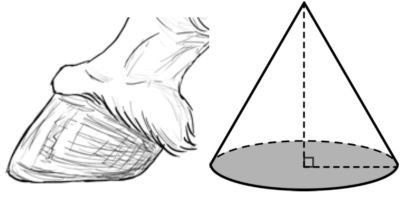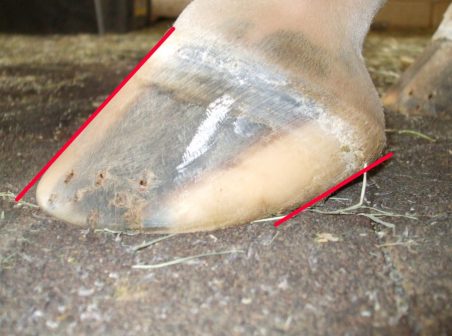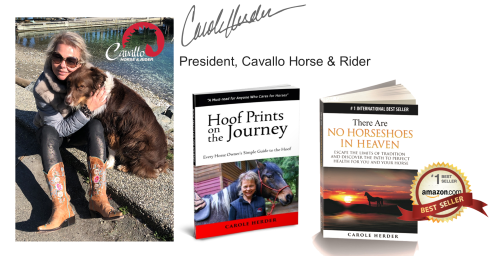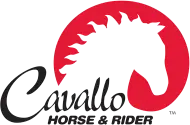Sustaining the Hoof – Managing Underrun Heels

Underrun heels are a degenerative condition when the heel wall angle is less than that of the toe wall. The heel distorts inward and under the hoof rather than slanting outward towards the back. Contrast this to a healthy hoof. In a healthy hoof, the heel is on an angle away from the toe. This constructs a larger, weight-bearing platform, thereby better accommodating the horse’s weight.
Underrun Heels – All Too Common
Unfortunately, underrun heels are a common disorder. Without intervention, the condition exacerbates. Every time the heel lands first, it pushes further towards the toe. This affects the entire hoof capsule’s veracity and squishing the heel’s anatomical structure and function. Crushing these soft tissues causes heel pain and forces the horse to change his way of going, by creating an unnatural toe first landing. Inflammation then occurs, setting up subsequent scenarios for problems. These effects are not only structural, but can also damage tissues, organs, and over time lead to DNA damage, tissue death, and internal scarring. All of which are linked to the development of other diseases, even including cancer.
It’s All About the Shape
 We have learned that one critical component of the hoof’s strength lies in keeping with the optimal functioning of a basic geometric shape. This shape is a fundamental asymmetrical cone, where the length at the toe is longer than the length at the heel. From teepees to the Eiffel Tower to volcanoes – cone shapes are strong. The wider load-bearing radius at ground level supports the narrowing load above. The larger circumference shape at ground-level closely matches the smaller circumference at the coronet band.
We have learned that one critical component of the hoof’s strength lies in keeping with the optimal functioning of a basic geometric shape. This shape is a fundamental asymmetrical cone, where the length at the toe is longer than the length at the heel. From teepees to the Eiffel Tower to volcanoes – cone shapes are strong. The wider load-bearing radius at ground level supports the narrowing load above. The larger circumference shape at ground-level closely matches the smaller circumference at the coronet band.
The Arch of Strength
Furthermore, this proper cone shape encourages an arch that reaches across the hoof at the base. The arch spans one side to the other, helping to create the sole’s imperative concavity. Like a bridge, arches tolerate significant weight. The structural arch is affected by the work of the farrier and the trim. When wrongly managed, the contributing problems most often seen are underslung heels, poorly balanced flares, and too-long toes.
As the horse’s weight descends, the hoof cone’s ground radius should expand to accept the load. If the walls are too steep, the cone is imbalanced. Alternatively, if the hoof is shaped as a cylinder or a tube, this miraculous weight-bearing function is thwarted. If this erroneous tube shape continues too long, serious problems develop.
Nature Knows her Stuff!

Photo credit: Yvonne Welz
Unlike the Eiffel tower, the anatomy of a cone-shaped hoof is designed to be biomechanically active. One may wonder why the brilliance of nature would leave the hoof’s solar radius unfinished. The circle or oval shape is incomplete. It stops at the heels and turns forward toward the toe creating the bars of the hoof. Not only do the bars add additional support, but the separation at the heels also allows for an expansion unrestricted by an otherwise complete circumference. The natural weight-bearing function of the hoof performs perfectly when not constricted by the metal shoe. It is the design mechanism that allows the frog to circulate blood and facilitate the heel spreading function. If the function is diminished by applying metal shoes, the frog is raised entirely off the ground, and the heels disintegrate further forwards and under.
You Can’t Shock a Good Hoof
The frog must contact the ground to spread the heels and assist in circulating blood down through the extremities and back up again to the heart. Spreading the heels draws the sole flat to allow the leg’s bone structure to descend into the hoof. Shock is absorbed in the hoof capsule. This circulatory system is imperative for distributing nutrients throughout the entire body and aids in disease prevention and enabling healing. If the frog cannot make ground contact and function as it should, then shock cannot be adequately absorbed, and blood cannot freely flow.
Recovery is best achieved by addressing the cause and root of the issue. Although it seems it is the heel that needs attention, underrun heels would not be an issue with adequately performing hoofs. Nothing about dynamic living cellular structure can be considered in isolation. The hoof is a relatively small structure compared to the overall horse. One thousand pounds of weight can only be adequately accommodated with a good hoof, healthy frog, and adequate digital cushion function. Prevention takes the form of balance, optimal weight distribution, proper roll-over landing mechanism, much blood, and oxygen supply. It is a dynamic relationship with live tissue.
Sustain the Hoof to Support the Horse
Supporting frog function, eliminating the forward running toe, and balancing breakover will inhibit the lever force that can drag the heel forward. Furthermore, if there is an option to lower the heel platforms without placing too much pressure on the sole, it delivers a broader support base. Scooping out the quarters at ground level may encourage the cornet band to release and avoid uncomfortable upward pressure. The hairline should always present as a straight rather than curved line.
An additional consideration is to create and maintain a lifestyle that meets Equus evolutionary requirements for movement, hydration, socialization, and nutrition. It should also be noted that extenuating circumstances such as club foot, joint deformity or spinal injuries may prevent 100% recovery of underrun heels. Some horses will always struggle with this. Issues, such as a lumbar spine injury (a horse being started too early, competed too hard or ridden heavily on a poorly fitting saddle) can set underrun heel syndrome early on.
Horses can improve over the years with properly balanced trimming but keeping heels back at the optimum location is imperative. Cavallo Boots can quickly be popped on for added support, comfort, and shock absorption during times of sensitivity. In the long term, it pays to sustain the equipment that supports a horse, rather than struggling to rehabilitate from the distortion.
– By Carole Herder
At Cavallo, we are here to help. Read more here: www.cavallo-inc.com/category/horsecare-educational-resources/
Want to hear more from Cavallo?
Sign up for our free newsletter and special community discounts! PLUS, get a coupon code for 10% off any Cavallo-branded products: www.cavallo-inc.com/CavalloNews

